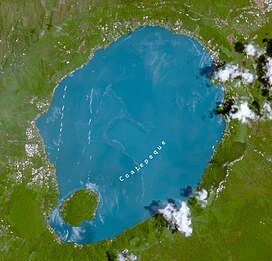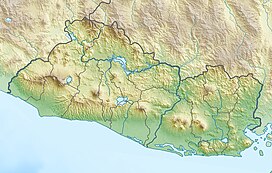Coatepeque Caldera (Nawat: cōātepēc, "at the snake hill") is a volcanic caldera in El Salvador in Central America. The caldera was formed during a series of rhyolitic explosive eruptions from a group of stratovolcanoes between about 72,000 and 57,000 years ago. Since then, basaltic cinder cones and lava flows formed near the west edge of the caldera, and six rhyodacitic lava domes have formed. The youngest dome, Cerro Pacho, formed after 8000 BC.
| Coatepeque Caldera | |
|---|---|
 Satellite view of the Coatepeque Caldera | |
| Highest point | |
| Elevation | 746 m (2,448 ft)[1] |
| Coordinates | 13°52′N 89°33′W / 13.87°N 89.55°W |
| Dimensions | |
| Length | 7 km (4.3 mi) |
| Width | 10 km (6.2 mi) |
| Naming | |
| Native name | Cōātepēc (Pipil) |
| English translation | "at the snake hill" |
| Geography | |
| Country | El Salvador |
| Department | Santa Ana |
| Municipality | Coatepeque |
| Geology | |
| Formed by | Volcanic eruption |
| Mountain type | Caldera, stratovolcanoes[1] |
| Type of rock | Rhyolite, Dacite, Andesite/Basaltic andesite |
| Volcanic arc | Central America Volcanic Arc |
| Last eruption | 72,000 and 57,000 years ago |
| Lake Coatepeque | |
| Lago de Coatepeque (Spanish) | |
 | |
| Location | Coatepeque, Santa Ana |
| Coordinates | 13°51′53″N 89°32′48″W / 13.864702°N 89.546800°W |
| Type | Caldera lake |
| Basin countries | El Salvador |
| Max. length | 7 km (4.3 mi)[2] |
| Max. width | 10 km (6.2 mi)[2] |
| Surface area | 10 sq mi (26 km2) |
| Average depth | 115 ft (35 m) |
| Max. depth | 115 m (377 ft) |
| Surface elevation | 745 m (2,444 ft) |
| Islands | Isla Teopán |
| References | [2] |
Lake Coatepeque
editLake Coatepeque (Lago de Coatepeque) is a large crater lake in the east part of the Coatepeque Caldera. It is in Coatepeque municipality, Santa Ana, El Salvador. There are hot springs near the lake margins. At 26 square kilometres (10 sq mi), it is one of the largest lakes in El Salvador. In the lake is the island of Teopan, which was a Mayan site of some importance.
Lake Coatepeque is also known to change colors from blue to turquoise. According to authorities of the,[3] this is a cyclical phenomenon that occurs from time to time. The color change has happened in 1998, 2006, 2012, 2016, 2017, 2018, and 2019. [4]
See also
editReferences
edit- ^ a b "Global Volcanism Program | Coatepeque Caldera". Smithsonian Institution | Global Volcanism Program. Retrieved 13 April 2023.
- ^ a b c "Coatepeque Caldera - Location/Geological Setting". www.geo.mtu.edu. Retrieved 13 April 2023.
- ^ Ministry of Environment and Natural Resources of El Salvador
- ^ https://elsalvador.travel/destination/coatepeque-lake/en/
